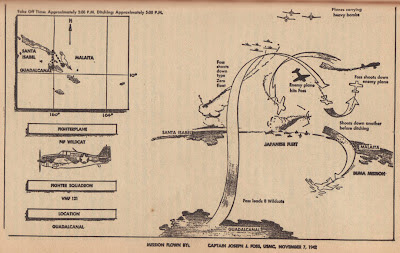DONE! I presented it to the Commissioner last Wednesday and...they like it!
At almost 30" long, this Wildcat is impressive on size alone and because of its size, was a real stretch for me. For my work, it's quite detailed. At the risk of sounding like the geek I am, I'm rather proud of the paint chips on the tailwheel shroud.
Anyway, presenting a finished piece is an interesting moment. In this case, we were standing around the conference table, arms behind backs (it always happens, people put their arms behind their backs and lean into the artwork), lots of "hmmm's" and "huh's" - then one of the guys breaks the silence and says, "You know, Joe Foss is definitely a candidate for The Most Interesting Man In the World*."
Really?!
Let's roll the facts on the man:
- Born at a farmstead with no electricity.
- Father dies; Joe drops out of school to run the family farm
- Saves $60, learns to fly, becomes Marine Corps aviator
- Refused combat duty because of his "old age"
- Learns fighters (F4Fs) on his own
- Ditches airplane in ocean, swims with sharks until rescued by Missionaries
- Shoots down 26 Japanese airplanes in aerial combat*
- Receives Medal of Honor for service between October '42 and January '43
- Starts his own businesses after the war (some worked, some didn't)
- Starts the South Dakota Air National Guard- Becomes a Brigadier General
- Wins two terms as Governor of South Dakota
- Loses a House seat race to George McGovern
- Turns down $750K for rights to make a movie about him
(and that's 1950s money, too!)
- Becomes Commissioner of the American Football League
- Hosts the TV show, American Sportsman
- Gets arsenic poisoning and becomes paralyzed
- Fights his way out of paralysis
- Becomes a born-again Christian
- Does PR for KLM Airlines
- Becomes President of the National Rifle Association
- Makes the cover of TIME Magazine
- Has an airport, high school and national foundation named for him...
...just "google" the guy.
"Joe Foss" is not just a name. It's an adjective, noun and verb.
However, he did share his 'formula' for success when I got to sit down with him in 2002. "I don't think about yesterdays. You want to do something, then you just go and do it."
It's really brilliant advice - devilish though because so few people want to see life so simply, so positively. To Joe, "success" was not complicated or mysterious. It was simply the result of continuous forward desire.
Ok. Now's a good time to show you a little artifact of Joe's wartime service - a page from the VMF-121's "War Diary" showing the day's activity for November 7, 1942.
Go ahead and read it - and notice the lack of info such as aircraft number, serial (BuNo) number. This is somewhat unusual in that aviators tend to keep detailed records on airplanes. It just goes to show that combat at Guadalcanal was chaotic.
Close your eyes - imagine a searing hot day, gluey humidity and the slap-crunch of leather shoes on coral gravel; the whine of an air raid siren - pilots leap up onto their Wildcats, engines belch to life...
On that November day, Joe experienced his 'Most Interesting' combat mission. After shooting down 3 Japanese aircraft, his last victory - a two-seat Japanese biplane - returned the favor; the enemy's rear gunner shot Joe down, too.Forced to ditch his F4F in the ocean, Joe almost didn't make it out of the cockpit. With a foot caught under the seat, Joe sank into the deep with the plummeting plane until - at about 30 foot depth - he wrenched himself free and shot to the surface.
Waterlogged, exhausted, Joe was now alone in the heaving sea. Sharks circled, hours passed, darkness arrived... then, a boat paddled by natives and a Missionary (really, I'm not making this up) approached, hauled him aboard... two days later, he's back in combat!
When I was a little kid - 3 or 4 - my father had this paperback book, "Greatest Fighter Missions" by a man named Edward Sims. Before the words made any sense, I'd pour over the book's little combat diagrams. They're really fantastic works of art as well as graphical stories. Whoever did them was a master!
Anyway, I still have the book, and the diagram of Joe Foss's November 7, 1942 mission has remained in-memory all this time. Now you can remember it too - see below. Cool huh?!
And see the little profile drawing of the Wildcat in the lower left hand corner? I distinctly remember trying to duplicate it, using crayons on the thick grayish paper my mom would give me. It just occurred to me - I started drawing Joe's Wildcat forty years ago!
You know, I'm glad I kept at it.
If I've learned anything from Joe Foss it's that circumstances are irrelevant. The man went from dirt-farm to Pacific Island to General to paralytic to...you get the point. In "the combat of life" success is not about what's happened or even what's going on currently. All things pass.
Success is about what you do next.
"I don't think about yesterdays. You want to do something, then you just go and do it."
And that's how you become Most Interesting Man in the World.
*********
POSTSCRIPT: An old SDANG pilot buddy of Joe's just emailed me. I thought you'd like to read what he wrote:
John: Liked your drawing of the F4F...I flew this plane a number of times. A stable plane but a crude cockpit. Upon takeoff with right hand on the stick and left hand on the throttle, I was forced to put the stick in my left hand and reach down to the floor with my right hand to hand crank up the wheels. When I looked up I had pushed the stick forward with nose headed for the ground. I bet the autos on the highway thought I was buzzing them. Upon landing I unlatched the catch and let gravity pull down the wheels. There was an inch of armor plate both behind the seat and under the seat. How Joe Foss ever shot down 26 Jap planes I'll never know.The Japenese Zero was much more manueverable because they had no armor plating and weighed less. But Joe was a crack shot, having hunted pheasants in South Dakota,he knew how to lead the target. After the war I flew P-51 Mustangs with Joe putting on many air shows for local celebrations. When I reminesce, how lucky can one get? I got to fly the F4F, the F4U, and the P-51 Mustang .........Semper Fi from an old (92 years) Marine fighter pilot from the carrier Wasp.
Claude Hone, VMF 216, SDANG
Sources: Artwork, me. VMF-121 War Diary courtesy of the U.S. Marine Corps History Division, Guadalcanal F4F photo ©unknown, Diagram: Greatest Fighter Missions by Edward M. Sims published by Ballantine Books, New York, 1962. Please holler if you know other proper attributes.

















